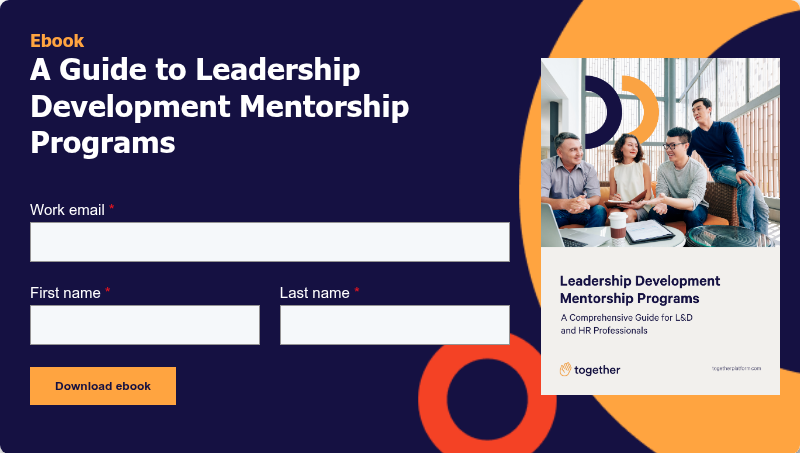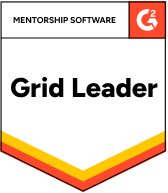You've done the hard work of designing your leadership mentorship program. You've identified selection criteria, developed training materials, and secured executive sponsorship. Now comes the make-or-break moment: rolling out your program in a way that generates excitement, builds credibility, and delivers results from day one.
According to Together's "Enterprise L&D in 2025" report, HR and L&D professionals predict that lack of growth opportunities will be the top factor in staff turnover. A well-executed mentorship program rollout can directly address this challenge while building organizational capability for the future.
But here's the reality: even the best-designed programs can fail if the rollout is poorly managed. The difference between programs that thrive and those that fizzle often comes down to execution details—how you build awareness, manage logistics, and create momentum from pilot through full launch.
This guide provides a practical, step-by-step approach to rolling out your leadership mentorship program, from initial pilot through organization-wide implementation.
The strategic pilot approach
Before launching organization-wide, start with a strategic pilot that allows you to test your assumptions, refine your processes, and build proof of concept that will fuel broader adoption.
Pilot program objectives
Your pilot should accomplish specific objectives that set up full-scale success:
Validate program design and processes:
- Test matching algorithms and relationship quality
- Evaluate training effectiveness and participant preparation
- Assess resource adequacy and support systems
- Identify gaps in program structure or materials
Build internal credibility and advocates:
- Create success stories that demonstrate program value
- Develop champion network of satisfied participants
- Generate data that supports broader investment
- Build confidence among skeptical stakeholders
Refine operational processes:
- Test administrative workflows and systems
- Identify bottlenecks and improvement opportunities
- Optimize resource allocation and support structures
- Develop scalable processes for larger cohorts
Pilot participant selection
Choose pilot participants strategically to maximize learning and build momentum:
High-probability success candidates:
- Participants with strong development motivation
- Mentors with proven development track records
- Functional areas with supportive leadership
- Teams facing clear leadership development needs
Diverse representation:
- Multiple business units and functional areas
- Various levels of leadership experience
- Different demographic backgrounds and perspectives
- Range of development needs and career aspirations
Influential participants:
- Well-respected employees with organizational credibility
- Natural connectors who influence others' opinions
- Leaders who can effectively communicate program value
- Individuals with networks that extend across the organization
Pilot size and duration
Optimal pilot scope: Research suggests pilots of 20-30 mentor-mentee pairs provide sufficient data while remaining manageable:
- Large enough to test matching processes and identify patterns
- Small enough to provide personalized attention and support
- Diverse enough to represent broader organizational population
- Focused enough to enable rapid iteration and improvement
Pilot timeline: Plan for a 6-month pilot that allows relationships to develop while providing timely feedback:
- Month 1: Recruitment, matching, and program launch
- Months 2-4: Relationship development and regular check-ins
- Month 5: Mid-program evaluation and adjustments
- Month 6: Completion, evaluation, and transition planning
Building internal awareness and buy-in
Successful program rollout requires building excitement and support across multiple stakeholder groups, each with different motivations and concerns.
Executive leadership engagement
Strategic positioning: Connect mentorship to business priorities and organizational challenges:
- Link program goals to strategic business objectives
- Demonstrate ROI potential through research and benchmarks
- Position as solution to talent retention and succession planning challenges
- Emphasize competitive advantage through leadership development
Executive participation: Ensure visible leadership engagement beyond just endorsement:
- Have executives share personal mentoring experiences
- Include program updates in leadership team meetings
- Connect program success to executive performance objectives
Resource allocation: Secure adequate investment for program success:
- Mentoring software and administrative support
- Training and development resources
- Time allocation for participant engagement
- Marketing and communication support
Middle management support
Middle managers often make or break mentorship programs through their support (or lack thereof) for participant engagement.
Manager education: Help managers understand program value and their role:
- Explain how mentorship supports their team members' performance
- Clarify manager responsibilities and expectations
- Provide guidelines for supporting participant engagement
- Address concerns about time investment and competing priorities
Incentive alignment: Create reasons for managers to actively support participation:
- Include mentorship support in manager performance evaluations
- Recognize managers who effectively develop their teams
- Provide development opportunities for supportive managers
- Connect team leadership development to business results
Communication strategy: Keep managers informed and engaged throughout the process:
- Regular updates on program progress and outcomes
- Best practice sharing from successful manager-participant partnerships
- Opportunities for manager feedback and input
- Clear escalation paths for addressing challenges
Participant community building
Awareness campaign: Build excitement and understanding about program opportunities:
- Multi-channel communication strategy (email, intranet, meetings, events)
- Success stories from pilot participants
- Clear explanation of program benefits and requirements
- Transparent application and selection process
Application process: Design recruitment that attracts quality candidates while managing volume:
- Clear eligibility criteria and application requirements
- Streamlined application process that respects participants' time
- Multiple application cycles to accommodate different readiness levels
- Transparent communication about selection timeline and criteria
Community building: Create sense of belonging and shared purpose among participants:
- Cohort-based onboarding and orientation sessions
- Regular networking events and learning opportunities
- Online platforms for sharing experiences and resources
- Alumni networks that continue beyond formal program participation
Managing logistics and operations
Smooth operations are essential for positive participant experience and program credibility. Plan for scale from the beginning, even during pilot phases.
Technology platform implementation
Platform selection and setup: Choose technology that supports current needs while enabling future growth:
- Matching capabilities that improve with scale
- Administrative tools that reduce manual work
- Participant experience features that drive engagement
- Integration capabilities with existing HR systems
Data migration and integration: Ensure seamless information flow between systems:
- Employee data integration from HRIS systems
- Performance and development data connections
- Calendar and communication tool integrations
- Reporting and analytics platform connections
User training and support: Prepare participants for effective platform utilization:
- Comprehensive training on platform features and capabilities
- Quick reference guides and help documentation
- Technical support processes and escalation paths
- Regular platform updates and feature announcements
Administrative workflow development
Participant lifecycle management: Create efficient processes for managing participants from application to completion:
- Application review and selection workflows
- Onboarding and orientation processes
- Ongoing support and check-in procedures
- Program completion and transition planning
Matching process optimization: Develop scalable approaches to creating quality mentor-mentee pairs:
- Data collection and analysis for matching decisions
- Matching criteria weighting and algorithm refinement
- Quality assurance and relationship monitoring
- Re-matching processes when relationships aren't working
Resource management: Ensure adequate resources are available to support program participants:
- Training material development and maintenance
- Facilitator and coach availability for support
- Meeting space and technology resources
- Budget management and expense tracking
Communication and marketing strategy
Internal marketing campaign: Build awareness and excitement through targeted communication:
- Leadership messaging emphasizing program importance
- Success stories and testimonials from pilot participants
- Clear value proposition for different audience segments
- Multi-channel approach using various communication platforms
Ongoing communication: Maintain engagement throughout program lifecycle:
- Regular updates on program progress and achievements
- Participant spotlights and success celebrations
- Resource sharing and learning opportunity announcements
- Feedback collection and program improvement communication
External recognition: Leverage external validation to build internal credibility:
- Industry award submissions and recognition opportunities
- Conference presentations and thought leadership content
- Benchmark sharing with other organizations
- Media coverage and public relations opportunities
Scaling from pilot to full implementation
The transition from pilot to full-scale implementation requires careful planning to maintain quality while significantly increasing program size.
Pilot evaluation and learning integration
Comprehensive pilot assessment: Analyze pilot results to inform full-scale design:
- Participant satisfaction and engagement metrics
- Relationship quality and outcome measurement
- Process efficiency and administrative burden analysis
- Cost-benefit analysis and ROI calculation
Process refinement: Use pilot learning to optimize full-scale processes:
- Matching criteria and algorithm improvements
- Training content and delivery method refinements
- Support system enhancements and resource additions
- Technology platform optimizations and feature additions
Stakeholder feedback integration: Incorporate input from all pilot participants and stakeholders:
- Mentor feedback on training and support adequacy
- Mentee input on program structure and resource needs
- Manager perspectives on employee experience and business impact
- Executive assessment of strategic value and ROI potential
Phased rollout strategy
Geographic or functional rollout: Consider staged implementation by business unit or location:
- Start with most supportive and prepared organizations
- Learn from each phase before expanding to next groups
- Build success stories and best practices along the way
- Manage resource requirements and administrative capacity
Cohort-based expansion: Launch multiple cohorts throughout the year:
- Allow for continuous program improvement between cohorts
- Distribute administrative workload across time periods
- Enable peer learning between different cohort groups
- Create multiple entry points for interested participants
Capacity building: Scale support infrastructure alongside participant numbers:
- Training additional program facilitators and coaches
- Expanding technology platform capacity and features
- Developing mentor pipeline and preparation processes
- Building administrative support and process automation
Quality assurance at scale
Consistency maintenance: Ensure program quality doesn't deteriorate with growth:
- Standardized training materials and delivery processes
- Quality metrics and monitoring systems
- Regular audit and improvement processes
- Feedback collection and response mechanisms
Mentor development pipeline: Build sustainable mentor recruitment and development:
- Alumni mentor development from previous mentee cohorts
- External mentor recruitment from industry networks
- Ongoing mentor training and skill development programs
- Mentor recognition and retention strategies
Continuous improvement culture: Embed learning and adaptation into program operations:
- Regular program review and update cycles
- Participant feedback integration processes
- Best practice identification and sharing systems
- Innovation and experimentation opportunities
Measuring rollout success
Track both implementation success and program outcomes to demonstrate value and identify improvement opportunities.
Implementation metrics
Rollout execution indicators:
- Recruitment and participation rate achievements
- Program launch timeline adherence
- Stakeholder satisfaction with rollout process
- Resource utilization and budget management
Operational efficiency measures:
- Administrative time and cost per participant
- Technology platform utilization and satisfaction
- Process cycle times and bottleneck identification
- Support request volume and resolution effectiveness
Program impact measurement
Short-term outcomes:
- Participant engagement and satisfaction scores
- Relationship quality and meeting frequency metrics
- Goal achievement and development progress indicators
- Manager and executive satisfaction with program value
Long-term business impact:
- Leadership pipeline strength and succession readiness
- Employee retention and engagement improvements
- Internal promotion and mobility rates
- Organizational culture and development practice changes
Building momentum for long-term success
Successful rollout creates foundation for sustained program success and organizational impact.
Creating program champions
Participant alumni networks: Build ongoing engagement beyond formal program participation:
- Alumni mentoring opportunities for former participants
- Peer coaching and support network development
- Success story sharing and program promotion
- Continuous learning and development opportunities
Executive sponsor engagement: Maintain leadership commitment and visibility:
- Regular program review and strategic alignment discussions
- Executive participation in program events and celebrations
- Leadership messaging about program importance and value
- Resource allocation and investment decision support
Continuous evolution and improvement
Feedback integration processes: Build systematic approaches to program enhancement:
- Regular participant survey and focus group collection
- Data analysis and trend identification systems
- Program modification and improvement implementation
- Communication about changes and rationale
Innovation and experimentation: Encourage ongoing program innovation:
- Pilot testing of new program features and approaches
- External best practice research and integration
- Technology platform enhancement and optimization
- Partnership development with other organizations and vendors
Your rollout success framework
Rolling out a leadership mentorship program successfully requires careful planning, strategic execution, and continuous attention to both participant experience and operational excellence. The framework in this guide provides a roadmap for moving from concept to sustainable, organization-wide impact.
Remember that rollout success is measured not just by participation numbers, but by the quality of relationships formed, the development achieved, and the organizational capability built for the future. Focus on creating experiences that participants value so highly they become advocates for continued program investment and expansion.
For a complete implementation guide including detailed project plans, communication templates, and measurement frameworks, download our comprehensive resource: "Leadership Development Mentorship Programs: A Comprehensive Guide for L&D and HR Professionals."
This guide provides everything you need to execute a flawless rollout that builds credibility, generates excitement, and delivers measurable business impact from day one.
Download the Leadership Development Mentorship Programs Ebook →



.svg)







.svg)

